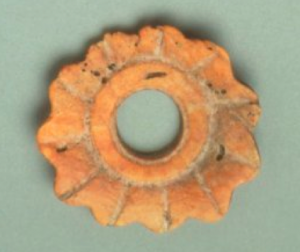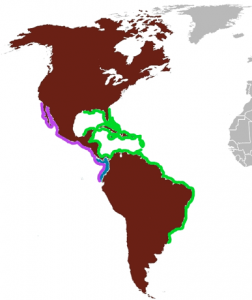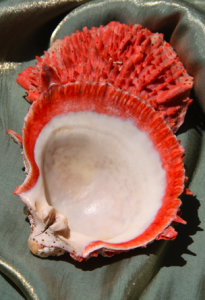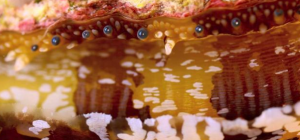The spiny oyster is found in warm waters all over the planet; however, the three main species utilized by indigenous Americans are Spondylus americanus, S. calcifer and S. princeps. These bivalve mollusks are found in relatively warm, shallow to semi-deep waters along the coasts. S. americanus is represented in green on the map, S. calcifer in purple, and S. princeps in blue.
Spondylus hatch from eggs as free-swimming larvae and develop a bumpy shell, extending a foot for attachment onto coral reefs or rocky masses at depths of up to 50 meters. Adults generally remain cemented for the rest of their lives and must be forcibly cut free for harvesting. During the summer they disperse either eggs or sperm into the water, the spread of which may be aided by flapping the shell. They feed by filtering particles from the water and their sharp spines protect against predators.

Spondylus Shell Earspool Maya, Mesoamerica Michael C. Carlos Museum 1994.018.002 Gift of Cora W. and Laurence C. Witten II
American Spondylus exhibit varying degrees of red coloration, the deeper the attachment the darker the hue. S. americanus can range from white, pink, orange, yellow, or red, but specimens retrieved from deeper water tend to be darker red. This Maya earflare would therefore be S. americanus and arguably a little lower in overall status due to its light shade. S. calcifer is red and white variegated with a purple band around the inner lip of the shells, while S. princeps is solid red.
The bivalve shells open for feeding and close when threatened. When open, a row of small round, sometimes bright blue eyes on stalks appear below each of the shell edges. (Click here or on the picture below to see video of this in motion.) The multiple eyes can detect changing patterns of light and motion. Such eyes would be suggestive of extra special sight, as in a shaman’s trance visions, and help provide a symbolic visual link between Spondylus and spiritual practice. This link is more than visual, however, as ingesting these animals can produce mild trance effects.
The meat of the Spondylus becomes toxic during seasonal increases in algae concentrations and at these times that small amounts of the meat could be eaten for its entheogenic properties. The coastal waters dramatically turn red during these algae blooms, alerting coastal inhabitants of the coming transformation in the Spondylus meat. While consuming Spondylus at this time is potentially lethal, the level of toxicity could be controlled by cooking. Dried, smoked oyster meat preserved the entheogenic properties, making it a highly valuable elite and religious trade item.
The difficulty in diving and harvesting the shells from the rocks in their deep sea water homes, the small amount of workable material obtained from a single individual, and the entheogenic effects of consumption contributed to the high status of this material throughout the ancient Americas.


